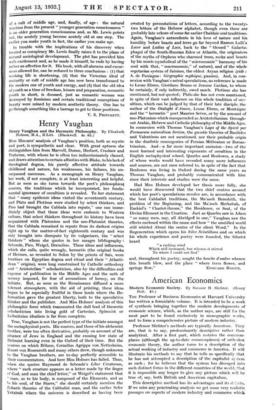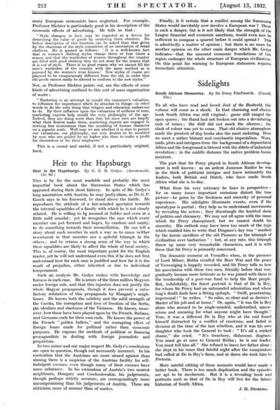American Economics Modern Economic Society. By Sumner H. Slichter. (Henry
Holt. $5.)
THE Professor of Business Economics at Harvard University has written a formidable volume. It is intended to be a work of synthesis bringing together the modern developments of economic science, which, as the author says, are still for the most part to be found exclusively in monographic works, and to form a comprehensive picture of modern industry.
Professor Slichter's methods are typically American. They are, that is to say, predominantly descriptive rather than analytical. After a first part, which restates the common- places (although the up-to-date commonplaces) of orthodox economic theory, the author turns to a description of the actual working of industry and commerce in America. It will illustrate his methods to say that he tells us specifically that he has not attempted a description of the capitalist system as such ; for he believes that the system has diverged into such distinct forms in the different countries of the world, that it is impossible any longer to give any picture which will be' true of, say, both British and American capitalism.
This descriptive method has its advantages and its dz.:mtg. If we miss any penetrating analysis we get some very realistic passages on aspects' of modern industiy and commerce which;
many European economists have neglected. For example,. Professor Slichter is particularly good in his description of the economic effects of advertising. He tells us that :
" Style changes, in fact, may be regarded as a device for destroying the value of goods by rendering them obsolete. No better description of this function can be asked than that given by the chairman of the style committee of an assoeiation of retail clothiers. He is quoted as follows : It is a well-known fact that in women's clothing styles change three or four times a season and that the wardrobes of women throughout the country are filled with good clothing they do not wear for the reason that it is out of style. There is no good reason why we cannot fill the men's wardrobes of the country with the same method as is pursued by the women's wear houses.' New styles of course are planned 'to be conspicuously different from the old, in order that old goods cannot easily be altered to conform to the new styles."
Nor, as Professor Slichter points out, are the effects of some kinds of advertising confined to this sort of mass organization of waste : " Marketing is an attempt to mould the consumer's valuation, to influence the importance which he attaches to things—in other words to do the very thing that religion and education endeavour to do. By their influence upon the valuations of millions of men, marketing experts help mould the very philosophy of the age. Indeed, they are doing more than this, for since men are largely what their desires make them, marketing experts are engaged in nothing less momentous than the moulding of human character on a gigantic scale. Well may we ask whether it is wise to permit our valuations, our philosophy, our very desires to be moulded by men who are guided by no higher aim than to make a profit for themselves or for their employers."
This is a sound and useful, if not a particularly original, book.































 Previous page
Previous page